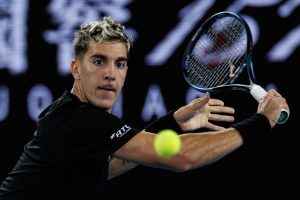Andy Murray has been tested more than most players. He has been tested by the weight of expectation at the place that tennis holds most sacred. He has been tested by a body that has struggled to live up to the demands imposed on it by the modern game. And he has been tested by playing in the same era as the three players who will surely be remembered as the greatest and most gifted men ever to step foot onto a tennis court.
But in spite of all of that, he has carved out a career for himself that for many years saw him accounted the equal of those players, even if he was somehow always decidedly the fourth amongst equals. Regardless, Murray will certainly receive a place in the Hall of Fame when he retires, one he has earned with three Grand Slam titles, two Olympic gold medals and one year-end #1 finish. But when all is said and done, as it surely will be all-too soon, it is hard to think that is what will be remembered.
Instead, it will be the long summer evenings at Wimbledon keeping Centre Court enthralled in dramatic battle after dramatic battle. He did not win them all and for a long time it seemed like he would never win the most important one of all. But Murray proved that he is not a man to be denied easily. That’s why he has won two titles at Wimbledon – as many as Rafael Nadal and many other great champions – and why he is still playing long after he was supposed to have retired.
He has a different hip now and a different attitude. Less is expected, but that only serves to make what is received that much more precious. Especially after everything else that has happened over the last 18 months. With the roar (it is invariably a roar now) of the crowd in his ears, a crowd that had been shown something close to tennis perfection in the morning and a three-set thriller in the afternoon, Murray set about his task with his usual grim determination.
Oscar Otte, his opponent, played his part to perfection. He may have won only four tour-level matches when he arrived at Wimbledon, but the ATP Challenger Tour breeds tough competitors and Otte has been well-schooled by that circuit. He does not lack talent either, with an unusual but powerfully effective game, based chiefly around an accurate, hard to read serve and a flat forehand he is typically happy to pull the trigger with.
After a relatively slow start, he showed Murray exactly what he could do for two sets. Time and again, Otte seized on Murray’s second serve, punishing the shot that has always been the Briton’s greatest weakness. As the weight of Otte’s blows grew heavier, Murray’s shoulders began to slump and his barking criticisms of himself grew louder and more acerbic. But for Murray, on Centre Court, that is rarely the end of the drama. More an interval before the second act.
As he has so often, Murray was merely testing Centre Court’s belief in him, repaying them in kind for the examination Wimbledon set for his character. He passed that twice, just as he passed the test posed by Otte. In the fourth set, the barest hint of doubt crept into the German’s game and Murray seized on it. With all of his experience and his pedigree behind him, he fought and scrapped until Otte eventually had to give in. Just like so many others have before him.
Of course, Otte has played relatively few best-of-five matches and in the first round found himself in a tiebreak at 12-12 in the fifth set. He cannot have been at his freshest when the match began, let alone by the time it ended. But then Murray had played only six matches all year when he stepped on to Centre Court. This was not the former-world #1 at his very best. It was far from the perfect performance and, in truth, a better player than Otte would likely have won this match. At some point this fortnight, one almost certainly will.
But that isn’t important. Tennis, sport more generally, is not just about the end result, titles won and records broken. If the long absence of fans and the dull slog of watching and playing sport in empty stadiums has taught us anything it is that. It’s a lesson that is worth remembering, particularly as tennis fans inevitably speculate about which of the ‘Big Three’ will end their careers with the most Major titles and the waning years Serena Williams’ career become more and more mired in her quest for number 24.
Time is against Murray now. It has not caught up with him yet – he did beat the world #28 in the first round – but it is inevitable that thoughts begin to turn to his legacy. But what Murray made Centre Court feel and what they gave back to him in return is sport in its purest form. It’s the joy, and in Otte’s case the misery, of competition. It’s the magical things that only the greatest of players can do. The flashing forehand winner on the run deep into the fifth set and the sublime lob to finally end it.
Those things do not have meaning only as a stepping stone to ultimate success. The crowd did not lend Murray their support when he needed it, and oh how he needed it, in the expectation that he will end this tournament with the title. It was simpler than that. Centre Court believed in Murray and he rewarded them with victory. A victory that perhaps more than any other was theirs to share in. If these moments are to serve as Murray’s legacy then it is one that he, and they, can be proud of.
Main photo:
Embed from Getty Images






